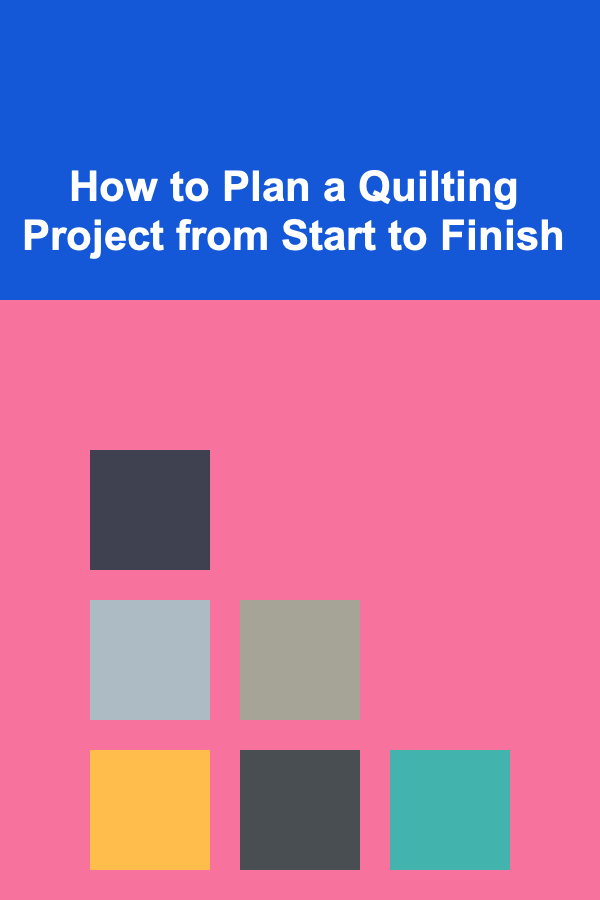
How to Plan a Quilting Project from Start to Finish
ebook include PDF & Audio bundle (Micro Guide)
$12.99$7.99
Limited Time Offer! Order within the next:

Quilting is a rewarding and creative craft that allows individuals to combine art with functionality. Whether you're an experienced quilter or a beginner, planning a quilting project is a crucial step to ensure the finished product is both beautiful and well-constructed. From choosing the design and fabric to the final stitch, every step of the process requires careful thought and preparation. This guide will walk you through the entire quilting process, from start to finish, so that you can confidently create your quilt.
Setting Your Intentions for the Quilt
Before you even pick up your fabric or tools, it's important to think about the purpose of your quilt. Are you creating a decorative piece for your home? A gift for a loved one? Or perhaps a practical item such as a bedspread or throw?
- Purpose: Understanding the purpose of your quilt will help guide your fabric choices, colors, size, and design. If you're making a gift, consider the recipient's preferences. If it's for your home, think about the room's color scheme and overall aesthetic.
- Style: Decide what kind of quilt you want to make. Will it be traditional, modern, or something in between? Look for inspiration in quilting magazines, online forums, or through Pinterest to find a style that resonates with you.
Once you've established the purpose and style, you'll have a clearer direction for the rest of the project.
Choosing the Quilt Pattern
The next step in planning your quilting project is selecting a quilt pattern. A pattern provides the blueprint for your quilt, including the arrangement of blocks, colors, and the overall design.
- Skill Level: Make sure to choose a pattern that suits your skill level. Some patterns are more complex and may involve intricate piecing, while others are beginner-friendly and require simple techniques.
- Type of Quilt: There are different types of quilt patterns to consider, such as patchwork quilts, applique quilts, and paper-pieced quilts. Choose one that suits your preferences and expertise.
- Block Size and Layout: Pay attention to the size of the blocks in the pattern. Larger blocks can be quicker to make, while smaller blocks may provide more detailed designs but take more time to piece together. Additionally, consider how the blocks will be arranged and how that might affect the final appearance of your quilt.
Remember, the pattern sets the foundation for your quilt, so it's important to choose one that excites you and aligns with your project's goals.
Selecting the Fabric
Fabric selection is one of the most exciting parts of planning a quilt. The fabrics you choose will ultimately determine the look and feel of your project. When selecting fabric, consider the following:
- Fabric Types: Choose fabrics that are appropriate for quilting. Cotton is the most commonly used fabric for quilts due to its durability, ease of use, and variety of patterns. However, you may also want to experiment with other fabrics like flannel, linen, or silk, depending on the look you're going for.
- Color Palette: Select a color palette that complements the overall design of your quilt. Use a color wheel to help you create harmony with complementary, analogous, or triadic colors. Think about the mood or theme you want to convey with your quilt.
- Fabric Quantity: Most quilt patterns will provide a fabric requirement chart, which will help you determine how much fabric you'll need. Always buy a little extra fabric to account for errors or shrinking during the pre-washing process.
It's important to wash and press your fabrics before cutting them. Pre-washing helps to prevent any future shrinking and ensures that the colors won't bleed onto each other.
Cutting the Fabric
Accurate cutting is crucial to the success of your quilt. Even small discrepancies in size can result in blocks that don't fit together properly. To make sure your fabric pieces are cut precisely, follow these steps:
- Use a Rotary Cutter and Mat: A rotary cutter and cutting mat are essential tools for accurate cutting. They allow you to cut through multiple layers of fabric at once, ensuring consistent sizes for your pieces.
- Cutting Templates: If your quilt pattern requires irregular shapes, use templates to ensure accuracy. You can either buy pre-made templates or make your own using cardboard or plastic sheets.
- Accurate Measurements: Follow the pattern's cutting instructions closely, and always measure twice before cutting. Precision in cutting is key to the overall success of your project.
Keep in mind that some fabrics, especially those with patterns, may need to be cut in a specific direction to maintain the integrity of the design. Be mindful of the fabric grain and pattern orientation.
Piecing the Quilt Top
The piecing process is where the magic happens, as it involves sewing together the various fabric pieces to create the quilt top. Here's how to approach this step:
- Use an Accurate 1/4" Seam: A consistent 1/4" seam allowance is essential for piecing the quilt top. Use a sewing machine with a 1/4" foot or measure and mark your seam allowance on the fabric.
- Chain Piecing: Chain piecing is a technique that allows you to sew multiple pieces of fabric together quickly without cutting the threads between each one. This method helps save time and keeps fabric pieces organized.
- Press as You Go: Press each seam after you sew it, as pressing helps set the stitches and ensures that the blocks remain flat. Use a hot iron and press seams to the side or open, as indicated by the pattern.
As you piece the quilt top together, be sure to check the alignment of your blocks and make sure they fit together properly. If any seams don't align, it's better to fix them early rather than wait until the quilt is finished.
Adding Borders
Once your quilt top is pieced together, you can add borders to frame the design. Borders can help balance the quilt and give it a finished look.
- Choose Border Fabric: Select fabric for the borders that complements the quilt top. Borders can be a solid color or a patterned fabric, depending on the effect you want to achieve.
- Measure and Cut Borders: To ensure the borders are evenly spaced, measure the quilt top's length and width before cutting the border strips. It's essential to cut the borders accurately and sew them on carefully to maintain the quilt's symmetry.
Borders are optional, but they can add a lot of personality and finish to the quilt.
Assembling the Quilt Sandwich
The quilt sandwich consists of the quilt top, batting (the middle layer), and backing fabric. This is the foundation of your quilt and must be done with care to ensure the quilt's durability and comfort.
- Select Batting: Batting comes in a variety of thicknesses, materials, and textures. Choose a batting that suits the purpose of your quilt. For example, a thicker batting may be appropriate for a cold-weather quilt, while a thinner batting works better for a summer quilt.
- Cut the Backing Fabric: Your backing fabric should be at least 4 inches larger than the quilt top on all sides. This allows you to trim it later to the proper size.
- Baste the Layers: Use a basting spray, pins, or a basting stitch to hold the layers of the quilt sandwich together. Make sure the quilt top, batting, and backing are smooth and free of wrinkles before moving on to the quilting stage.
It's important to take your time when assembling the quilt sandwich to ensure the layers are perfectly aligned.
Quilting the Layers Together
Now comes the fun part: quilting the layers together. Quilting can be done by hand or with a sewing machine, depending on your preference and experience.
- Machine Quilting: If you're using a sewing machine, choose an appropriate stitch for your design. Some quilters use straight lines, while others prefer free-motion quilting for more intricate designs.
- Hand Quilting: If you're hand quilting, you can use a simple running stitch or experiment with other hand-stitching techniques like the traditional Baptist Fan design.
- Quilt Design: The quilt design can range from basic straight lines to more complex patterns. Consider the overall look of your quilt and whether you want the quilting to enhance the pattern or blend in with the fabric.
Take your time during this process, as quilting the layers together is what gives the quilt its texture and structure.
Binding the Quilt
Binding is the final step in finishing your quilt. The binding covers the raw edges of the quilt, giving it a polished, professional look.
- Cut the Binding Strips: Cut strips of fabric for the binding, typically 2.5 inches wide. The length of the strips will depend on the size of your quilt.
- Sew the Binding: Attach the binding to the quilt using a sewing machine, starting from one corner and working your way around the entire quilt. Make sure the edges are neatly folded and pressed as you sew.
The binding process can be time-consuming, but it's worth it for the clean, finished edge it provides to your quilt.
Final Touches and Care
Once the binding is finished, your quilt is complete, but there are still a few final touches to consider:
- Trimming: Trim any loose threads and make sure the quilt edges are even.
- Washing: Give your quilt a gentle wash to remove any markings and shrink the fabric slightly. Washing also softens the quilt, making it more comfortable to use.
Now that your quilt is complete, it's time to display it, gift it, or simply enjoy the fruits of your labor!
Conclusion
Planning a quilting project from start to finish requires thoughtful preparation, patience, and attention to detail. By following these steps, you can create a quilt that is not only beautiful but also well-made and durable. Whether you're making a quilt for yourself or as a gift, the process of choosing fabrics, designing the layout, piecing the blocks, and adding the finishing touches is a deeply satisfying experience that allows you to express your creativity. Remember, quilting is a journey---take your time, enjoy the process, and most importantly, have fun!
Reading More From Our Other Websites
- [Home Space Saving 101] How to Make the Most of Your Hallway for Storage
- [Home Pet Care 101] How to Travel Safely with Your Cat
- [Organization Tip 101] How to Manage Tools for Raised Bed Gardening
- [Sewing Tip 101] Maintenance Hacks: Keeping Your Sewing Machine Running Smoothly Year-Round
- [Small Business 101] How to Navigate Local Zoning Laws When Expanding a Home‑Based Business
- [Hiking with Kids Tip 101] Story-Path Adventures: Interactive Storytelling Games for Kids on the Move
- [Personal Care Tips 101] How to Choose the Best Makeup Primer for Reducing Redness and Blotchiness
- [Organization Tip 101] How to Organize Your Cleaning Supplies for Efficiency
- [Home Lighting 101] How to Use Natural Light to Make Your Home Feel Brighter
- [Metal Stamping Tip 101] From Prototype to Production: Streamlining Development with Precision Stamping

The Product Designer's Toolkit: Proven Methods for Designing Impactful and Usable Products
Read More
Top Ways to Profit from Deep Learning Projects
Read More
How to Scale Blockchain Solutions for Enterprise Use
Read More
How To Improve Your Decision-Making Speed
Read More
Mindfulness for Decision Making: A Deep Dive
Read More
10 Tips for Mastering the Art of Space Planning
Read MoreOther Products

The Product Designer's Toolkit: Proven Methods for Designing Impactful and Usable Products
Read More
Top Ways to Profit from Deep Learning Projects
Read More
How to Scale Blockchain Solutions for Enterprise Use
Read More
How To Improve Your Decision-Making Speed
Read More
Mindfulness for Decision Making: A Deep Dive
Read More